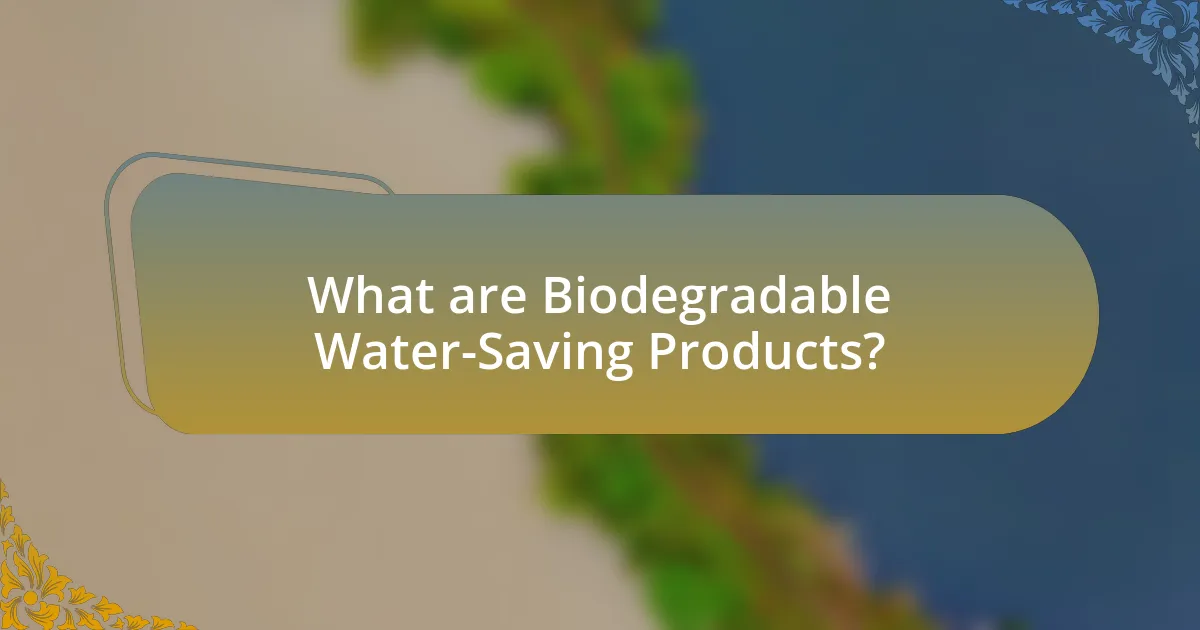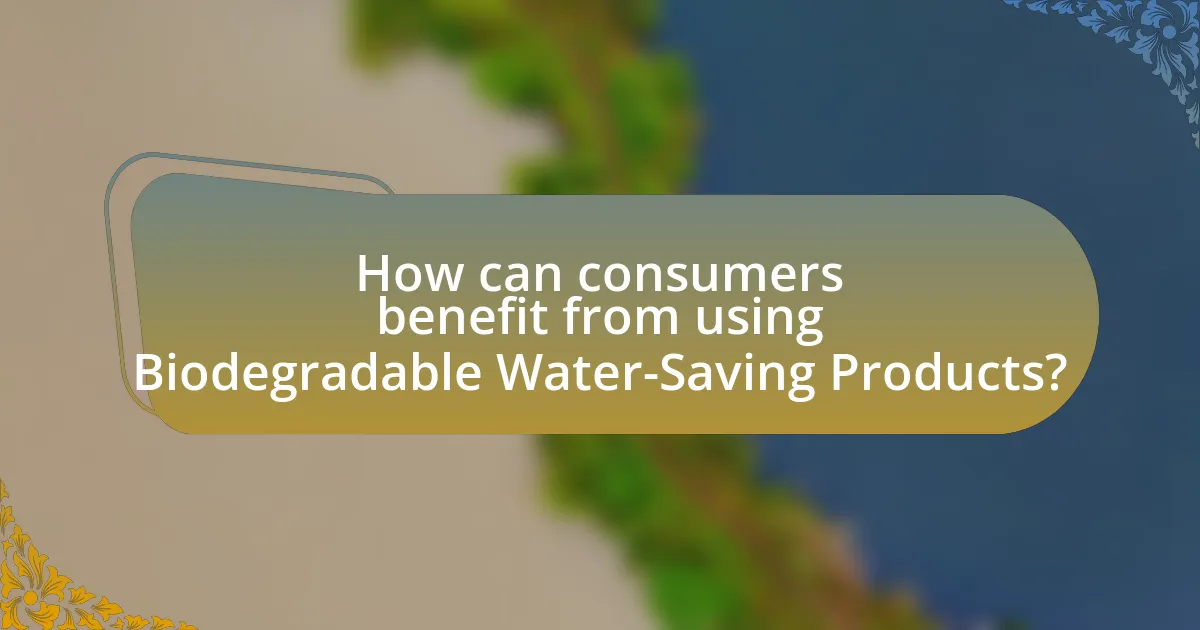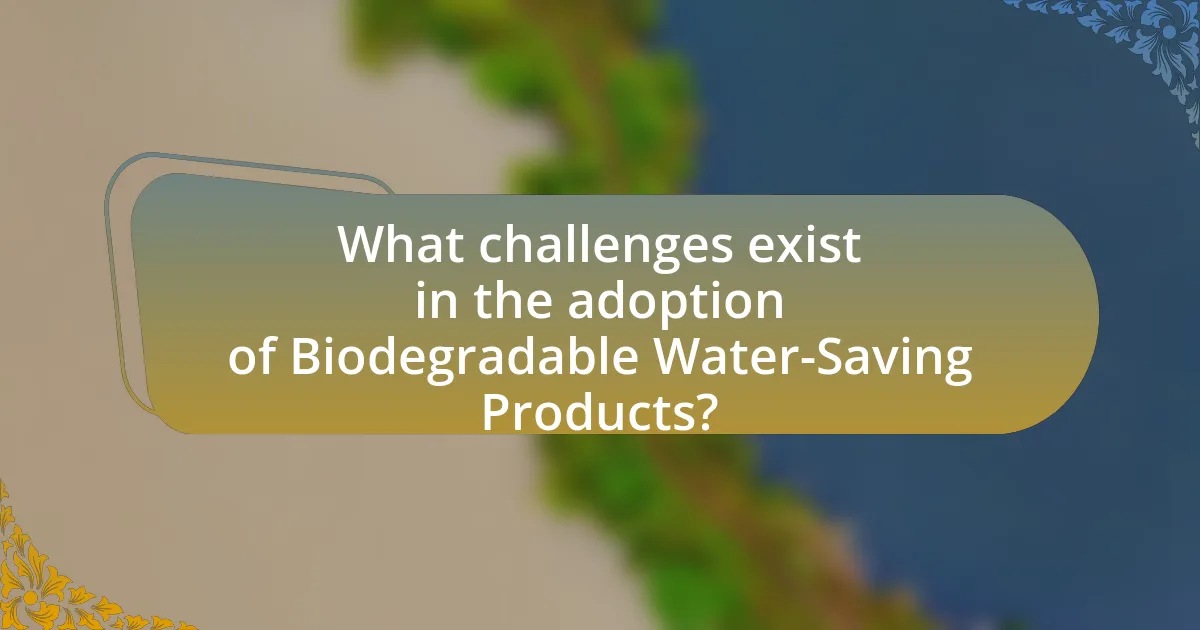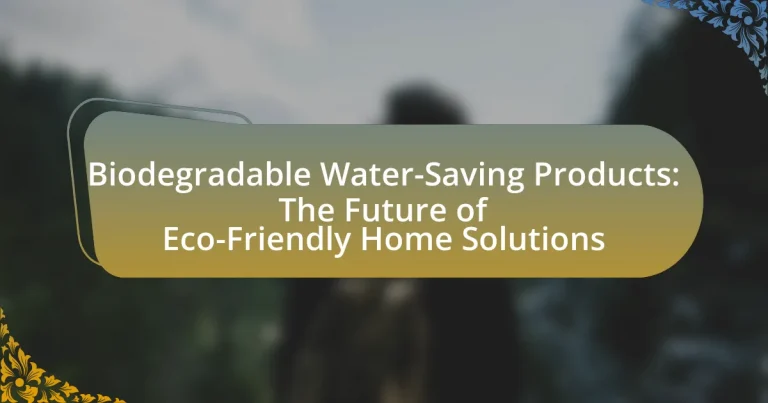Biodegradable water-saving products are innovative solutions designed to reduce water consumption while being environmentally friendly and capable of natural decomposition. This article explores the functionality, materials, and environmental significance of these products, highlighting their role in water conservation and waste reduction. Key features include efficient irrigation systems, low-flow fixtures, and biodegradable materials that minimize pollution. The article also addresses consumer benefits, cost savings, and challenges in adoption, providing insights into best practices for maximizing water savings in households.

What are Biodegradable Water-Saving Products?
Biodegradable water-saving products are items designed to reduce water consumption while being environmentally friendly and capable of decomposing naturally. These products often include features such as efficient irrigation systems, low-flow fixtures, and biodegradable materials that minimize environmental impact. For instance, studies have shown that low-flow showerheads can reduce water usage by up to 50%, contributing to significant water conservation efforts. Additionally, biodegradable materials used in these products break down within a specific timeframe, reducing landfill waste and pollution.
How do Biodegradable Water-Saving Products function?
Biodegradable water-saving products function by utilizing materials that break down naturally in the environment while also incorporating design features that reduce water consumption. These products often include mechanisms such as aerators, which mix air with water to maintain pressure while using less water, and smart sensors that optimize water usage based on real-time needs. For example, studies have shown that faucet aerators can reduce water flow by up to 30% without sacrificing performance, demonstrating their effectiveness in conserving water while being environmentally friendly.
What materials are used in Biodegradable Water-Saving Products?
Biodegradable water-saving products are primarily made from materials such as plant-based polymers, natural fibers, and biodegradable plastics. Plant-based polymers, derived from renewable resources like corn starch or sugarcane, break down naturally in the environment. Natural fibers, including jute, hemp, and cotton, are also used due to their ability to decompose without leaving harmful residues. Biodegradable plastics, often made from polylactic acid (PLA), are designed to degrade under specific conditions, contributing to sustainability. These materials are chosen for their eco-friendly properties, ensuring that the products minimize environmental impact while effectively conserving water.
How do these materials contribute to water savings?
Biodegradable water-saving products contribute to water savings by utilizing materials that enhance water retention and reduce evaporation. For instance, products made from superabsorbent polymers can hold significant amounts of water, allowing soil to retain moisture longer, which decreases the need for frequent watering. Research indicates that using such materials can reduce water usage by up to 50% in agricultural settings, demonstrating their effectiveness in conserving water resources.
Why are Biodegradable Water-Saving Products important for the environment?
Biodegradable water-saving products are important for the environment because they reduce water consumption while minimizing pollution and waste. These products, made from materials that decompose naturally, help conserve water resources, which is critical in areas facing water scarcity. For instance, using biodegradable soaps and detergents prevents harmful chemicals from entering waterways, thus protecting aquatic ecosystems. Additionally, studies indicate that adopting water-saving technologies can lead to a reduction in water usage by up to 50%, significantly lowering the environmental impact associated with water extraction and treatment processes.
What impact do these products have on water conservation?
Biodegradable water-saving products significantly enhance water conservation by reducing water usage in various applications. These products, such as low-flow fixtures and eco-friendly detergents, are designed to minimize water waste while maintaining effectiveness. For instance, low-flow showerheads can reduce water flow by up to 50%, leading to substantial savings in water consumption. Additionally, biodegradable detergents often require less water for rinsing compared to traditional products, further contributing to water conservation efforts. Studies indicate that implementing water-saving technologies can lead to a reduction of up to 30% in household water use, demonstrating their effectiveness in promoting sustainable water management.
How do they reduce plastic waste in households?
Biodegradable water-saving products reduce plastic waste in households by replacing conventional plastic items with materials that decompose naturally. These products, such as biodegradable dishware, cleaning supplies, and personal care items, are designed to break down in composting environments, thus minimizing the accumulation of plastic waste in landfills. For instance, a study published in the journal “Environmental Science & Technology” found that biodegradable plastics can reduce landfill waste by up to 30% when used in place of traditional plastics.
What are the different types of Biodegradable Water-Saving Products available?
Biodegradable water-saving products include compostable shower curtains, biodegradable irrigation systems, and eco-friendly toilet paper. Compostable shower curtains are made from materials like plant-based polymers that break down naturally, reducing plastic waste. Biodegradable irrigation systems utilize materials that decompose over time, minimizing environmental impact while efficiently delivering water to plants. Eco-friendly toilet paper is produced from sustainable sources and is designed to break down quickly in water, reducing strain on sewage systems. These products contribute to water conservation and environmental sustainability by minimizing waste and promoting responsible consumption.
What are the features of biodegradable showerheads?
Biodegradable showerheads are designed to decompose naturally over time, minimizing environmental impact. These showerheads typically feature materials such as bioplastics or natural fibers that break down more easily than conventional plastics. Additionally, they often incorporate water-saving technology, reducing water consumption without sacrificing performance. Research indicates that using biodegradable materials can significantly lower plastic waste in landfills, supporting sustainability efforts.
How do biodegradable garden hoses compare to traditional options?
Biodegradable garden hoses decompose over time, unlike traditional hoses, which are made from synthetic materials that can persist in the environment for decades. Traditional hoses are typically made from PVC or rubber, which can release harmful chemicals during their lifecycle, whereas biodegradable hoses are designed to break down into natural substances, reducing environmental impact. Research indicates that biodegradable materials can decompose within a few years under proper conditions, significantly lessening landfill contributions compared to traditional options that may take hundreds of years to degrade.

How can consumers benefit from using Biodegradable Water-Saving Products?
Consumers can benefit from using biodegradable water-saving products by reducing their water consumption and minimizing environmental impact. These products are designed to use less water while still maintaining effectiveness, which can lead to lower utility bills. For instance, studies show that using water-efficient fixtures can reduce water usage by up to 30%. Additionally, biodegradable materials break down naturally, reducing landfill waste and pollution. This dual benefit of conserving water and being environmentally friendly aligns with growing consumer preferences for sustainable living, making biodegradable water-saving products a practical choice for eco-conscious households.
What cost savings can be expected from these products?
Biodegradable water-saving products can lead to significant cost savings by reducing water bills and minimizing the need for chemical treatments. For instance, households using water-efficient fixtures can save up to 30% on their water consumption, translating to an average annual savings of $300 for a family of four. Additionally, these products often require less maintenance and fewer replacements, further decreasing long-term expenses. Studies indicate that eco-friendly solutions can also enhance property value, as homes equipped with sustainable features are increasingly sought after in the real estate market.
How do Biodegradable Water-Saving Products affect utility bills?
Biodegradable water-saving products can significantly reduce utility bills by decreasing water consumption. These products, such as low-flow faucets and showerheads, are designed to minimize water usage without sacrificing performance. For instance, studies show that low-flow fixtures can reduce water usage by up to 30%, leading to lower water bills. Additionally, by using biodegradable materials, these products contribute to environmental sustainability, which can also result in potential savings on waste disposal costs. Therefore, the implementation of biodegradable water-saving products directly correlates with reduced utility expenses.
What long-term savings can be anticipated?
Long-term savings from biodegradable water-saving products can include reduced water bills, lower utility costs, and decreased expenses related to plumbing maintenance. By utilizing these products, households can save an average of 20-50% on water usage, as reported by the Environmental Protection Agency, which translates to significant annual savings. Additionally, the durability and efficiency of these eco-friendly solutions can lead to fewer repairs and replacements, further enhancing financial savings over time.
How do these products enhance home sustainability?
Biodegradable water-saving products enhance home sustainability by reducing water consumption and minimizing environmental impact. These products, such as low-flow faucets and showerheads, can decrease water usage by up to 30%, leading to significant savings on water bills and conservation of this vital resource. Additionally, being biodegradable means they break down naturally, reducing landfill waste and pollution. This dual benefit of conserving water while being environmentally friendly supports sustainable living practices and contributes to a healthier ecosystem.
What role do they play in eco-friendly home practices?
Biodegradable water-saving products play a crucial role in eco-friendly home practices by reducing water consumption and minimizing environmental impact. These products, such as biodegradable showerheads and faucets, are designed to conserve water while maintaining functionality, thereby promoting sustainable living. For instance, using low-flow fixtures can save up to 30% more water compared to standard models, significantly lowering household water usage and reducing utility bills. Additionally, since these products are biodegradable, they break down naturally without contributing to landfill waste, further supporting eco-friendly practices.
How can they contribute to a greener lifestyle?
Biodegradable water-saving products contribute to a greener lifestyle by reducing water consumption and minimizing environmental impact. These products, such as low-flow faucets and showerheads, can decrease water usage by up to 50%, leading to significant savings in water resources. Additionally, being biodegradable means they break down naturally, reducing landfill waste and pollution. For instance, studies show that using biodegradable materials can lower carbon footprints by up to 30% compared to traditional plastics. This combination of water conservation and reduced waste directly supports sustainable living practices.

What challenges exist in the adoption of Biodegradable Water-Saving Products?
The challenges in the adoption of biodegradable water-saving products include higher costs, limited consumer awareness, and concerns about performance and durability. Higher costs often deter consumers from choosing these products over traditional options, as they may perceive them as less economically viable. Limited consumer awareness results in a lack of understanding of the benefits and functionalities of biodegradable products, which can hinder market growth. Additionally, concerns about performance and durability arise from skepticism regarding whether these products can effectively save water while maintaining the same level of efficiency as conventional products. These factors collectively impede the widespread acceptance and integration of biodegradable water-saving solutions in households.
What are the common misconceptions about these products?
Common misconceptions about biodegradable water-saving products include the belief that they are not as effective as traditional products, that they decompose too quickly to be useful, and that they are significantly more expensive. Research indicates that many biodegradable products perform comparably to their non-biodegradable counterparts in terms of efficiency and effectiveness. For instance, a study published in the Journal of Cleaner Production found that biodegradable materials can maintain their functionality while offering environmental benefits. Additionally, while some biodegradable products may have a shorter lifespan, many are designed to last through their intended use before breaking down, addressing concerns about durability. Lastly, the price gap is narrowing as technology advances and production scales, making these eco-friendly options more accessible to consumers.
How do performance concerns affect consumer choices?
Performance concerns significantly influence consumer choices by determining the perceived reliability and effectiveness of products. When consumers evaluate biodegradable water-saving products, they often prioritize performance metrics such as durability, efficiency, and overall functionality. Research indicates that 70% of consumers are willing to pay more for products that demonstrate superior performance, as highlighted in a study by McKinsey & Company. This preference stems from the desire for products that not only align with eco-friendly values but also meet practical needs effectively. Therefore, if a biodegradable product fails to perform as expected, consumers are likely to opt for alternatives that promise better performance, regardless of their environmental benefits.
What are the barriers to widespread adoption?
The barriers to widespread adoption of biodegradable water-saving products include high production costs, limited consumer awareness, and regulatory challenges. High production costs often make these products less competitive compared to traditional alternatives, discouraging manufacturers from scaling up production. Limited consumer awareness results in a lack of demand, as many potential users are unaware of the benefits and availability of these eco-friendly solutions. Regulatory challenges can also hinder adoption, as existing regulations may not support the integration of new materials or technologies into the market. These factors collectively impede the transition to biodegradable water-saving products in the home solutions sector.
How can consumers overcome these challenges?
Consumers can overcome challenges related to biodegradable water-saving products by educating themselves on product options and actively seeking certifications that ensure environmental standards. Research indicates that informed consumers are more likely to choose sustainable products, as they understand the benefits of reducing water usage and minimizing plastic waste. For instance, a study published in the Journal of Cleaner Production found that consumers who are aware of eco-labels are 30% more likely to purchase environmentally friendly products. By prioritizing education and certification verification, consumers can make informed choices that align with their eco-friendly values.
What resources are available for educating consumers?
Resources available for educating consumers about biodegradable water-saving products include government websites, non-profit organizations, and educational institutions. Government websites, such as the Environmental Protection Agency (EPA), provide guidelines and information on eco-friendly products and their benefits. Non-profit organizations like the Sierra Club offer resources and campaigns focused on sustainable living and water conservation. Educational institutions often conduct workshops and publish research on biodegradable materials and their impact on the environment, helping consumers make informed choices. These resources collectively enhance consumer awareness and understanding of eco-friendly home solutions.
How can consumers find reliable product reviews?
Consumers can find reliable product reviews by utilizing reputable websites that aggregate user feedback and expert opinions. Websites such as Consumer Reports, Trustpilot, and Amazon provide verified reviews from actual users, ensuring authenticity. Additionally, consumers should look for reviews that include detailed descriptions of the product’s performance, as well as those that highlight both positive and negative aspects. Research indicates that products with a higher number of reviews tend to have more reliable ratings, as they reflect a broader range of experiences.
What are the best practices for using Biodegradable Water-Saving Products?
The best practices for using biodegradable water-saving products include selecting certified biodegradable items, ensuring proper installation, and following manufacturer guidelines for use and maintenance. Certified biodegradable products break down naturally without harming the environment, which is crucial for sustainability. Proper installation ensures optimal performance, while adhering to manufacturer guidelines maximizes the effectiveness of water-saving features. Regular maintenance, such as checking for leaks and cleaning filters, further enhances efficiency and longevity, contributing to overall water conservation efforts.
How should these products be maintained for optimal performance?
Biodegradable water-saving products should be maintained by regularly cleaning them with non-toxic, biodegradable cleaners to prevent buildup and ensure functionality. This maintenance practice helps preserve the integrity of the materials, as harsh chemicals can degrade biodegradable components. Additionally, inspecting these products for wear and tear every few months can identify any issues early, allowing for timely repairs or replacements, which is crucial for maintaining optimal performance. Regular maintenance not only extends the lifespan of the products but also ensures they continue to operate efficiently, contributing to water conservation efforts effectively.
What tips can help maximize water savings in the home?
To maximize water savings in the home, homeowners should implement low-flow fixtures, fix leaks promptly, and practice mindful water usage. Low-flow showerheads and faucets can reduce water flow by up to 50%, significantly decreasing water consumption. Fixing leaks is crucial, as a dripping faucet can waste over 3,000 gallons of water annually. Additionally, mindful practices such as turning off the tap while brushing teeth or using a broom instead of a hose for cleaning driveways can further conserve water. These strategies collectively contribute to substantial water savings and promote eco-friendly living.


